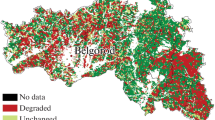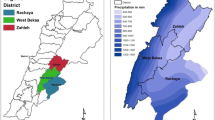Abstract
Early assessments of land degradation like the Global Assessment of Soil Degradation (GLASOD) (Oldeman et al. 1990) were compilations of expert opinion. They are unrepeatable and systematic data show them to be unreliable (Sonneveld and Dent 2009). Under the FAO/UNEP program Land Degradation in Drylands (LADA), Bai et al. (2008) undertook a global assessment of land degradation and improvement (GLADA) by analysis of linear trends of climate-adjusted GIMMS NDVI data. GLADA, the first quantitative assessment of global land degradation, aimed to identify and delineate hot spots of land degradation, and their counterpoint—bright spots of land improvement (Bai et al. 2008). The study revealed that about 24 % of the global land area was affected by land degradation between 1981 and 2003. Humid areas accounted for 78 % of the global degraded land area, while arid and semiarid areas accounted for only 13 %. Cropland and rangelands accounted for 18 % and 43 %, respectively, of the 16 % of global land area where the NDVI increased. The authors observed a positive correlation between population density and NDVI but, also, a correlation between poverty and land degradation. They emphasized that NDVI cannot be other than a proxy for land degradation and that it reveals nothing about the kind of degradation or the drivers (Bai et al. 2008).
Access provided by Autonomous University of Puebla. Download chapter PDF
Similar content being viewed by others
Keywords
These keywords were added by machine and not by the authors. This process is experimental and the keywords may be updated as the learning algorithm improves.
Early assessments of land degradation like the Global Assessment of Soil Degradation (GLASOD) (Oldeman et al. 1990) were compilations of expert opinion. They are unrepeatable and systematic data show them to be unreliable (Sonneveld and Dent 2009). Under the FAO/UNEP program Land Degradation in Drylands (LADA), Bai et al. (2008) undertook a global assessment of land degradation and improvement (GLADA) by analysis of linear trends of climate-adjusted GIMMS NDVI data. GLADA, the first quantitative assessment of global land degradation, aimed to identify and delineate hot spots of land degradation, and their counterpoint—bright spots of land improvement (Bai et al. 2008). The study revealed that about 24 % of the global land area was affected by land degradation between 1981 and 2003. Humid areas accounted for 78 % of the global degraded land area, while arid and semiarid areas accounted for only 13 %. Cropland and rangelands accounted for 18 % and 43 %, respectively, of the 16 % of global land area where the NDVI increased. The authors observed a positive correlation between population density and NDVI but, also, a correlation between poverty and land degradation. They emphasized that NDVI cannot be other than a proxy for land degradation and that it reveals nothing about the kind of degradation or the drivers (Bai et al. 2008).
Potential false alarms caused by drought cycles and rising global temperatures were removed by screening the data using rain-use efficiency (RUE) and energy-use efficiency (EUE). RUE was estimated from the ratio of the annual sum NDVI to annual rainfall calculated from the VASClimO station-observed monthly rainfall data gridded to 0.5° latitude/longitude (Beck et al. 2005); EUE was represented by the ratio of NDVI and accumulated temperature calculated from the CRU dataset (Jones and Harris 2013; Mitchell and Jones 2005). The sequence of operations was:
-
1.
Areas where biomass productivity depends on annual rainfall were identified as those with a significant positive relationship between NDVI and rainfall. In these areas, years of below-normal rainfall exhibit below-normal NDVI and also, usually, increased RUE. Where there is decreasing NDVI but steady or increasing RUE, the loss of productivity was attributed to drought and these areas were masked. Where both NDVI and RUE declined, something else is happening and these areas were included in the next stage of analysis.
-
2.
For the remaining areas where productivity is not limited by rainfall and, also, for those with a positive relationship between productivity and rainfall but declining RUE, greening and browning trends were calculated as RUE-adjusted NDVI. Similarly, EUE was used to separate trends caused by rising temperatures, the net result being a climate-adjusted NDVI.
-
3.
Urban areas were masked (this makes little difference to the global results −0.5 % for the identified degrading land and 0.2 % for improving land). Irrigated areas were not masked; the separation of areas of positive and negative correlation with rainfall effectively separates wetlands, irrigated areas, and areas with surplus rainfall from the areas where unadjusted NDVI is a good measure of degradation and improvement. Humid areas have not been masked; unadjusted NDVI was used for all of those areas where RUE is not appropriate.
-
4.
The T-test was used to test the significance of the linear regression; class boundaries were defined for 90, 95, and 99 % levels.
-
5.
To arrive at a measure amenable to economic analysis, NDVI trend was translated into gain or loss of NPP by correlation with MODIS 8-day NPP data (Running et al. 2004) for the overlapping period (2000–2006).
-
6.
Several indices of land degradation and improvement were compared with land cover, land use, and landform. Land-use change is a main driver of land degradation so it would be useful to undertake analysis of NDVI against change in land use and management, but there are no corresponding time series data for land use or land cover. GLC2000 (Bartholomé and Belward 2005) global land-cover and land-use systems of the world (FAO 2013) were used for preliminary comparison with NPP trends.
-
7.
Soil and terrain: A global soil and terrain database at scale 1:1 million-scale was compiled using the 90 m-resolution SRTM digital elevation model and a dataset of key soil attributes for the LADA partner countries (ISRIC 2008a, b). Correlations between land degradation and soil and terrain were investigated in country studies.
-
8.
Population, urban areas, and poverty indices: The CIESIN Global Rural–urban Mapping Project provides data for population and urban extent, gridded at 30 arc-second resolution (CEISIN 2004). Subnational rates of infant mortality and child underweight status and the gridded population for 2005 at 2.5 arc-minutes resolution (CEISIN 2007) were compared with indices of land degradation.
The picture revealed by GLADA was against received wisdom which reckoned that degradation was worst in the Sahel, the Amazon rain forest, and, more generally, in drylands. But the Sahel, Amazon, and drylands mainly showed increases in climate-adjusted NDVI. The areas hardest hit appeared to be Africa South of the Equator, Southeast Asia, the Pampas and Chaco regions in South America, North Central Australia, and swaths of the high-latitude forest belt extending across North America and Siberia. However, the identification of increases in the Amazon by Bai et al. (2008) may be questioned in the light of more recent studies by Morton et al. (2014) showing that the apparent greening of Amazon forests revealed in optical remote sensing data is due to seasonal changes in NIR reflectance—an artifact of variations in sun-sensor geometry (Morton et al. 2014). The picture is different again when the same analysis is applied to the extended GIMMS3g dataset for 1981–2011; the differences are not just because of the longer run of data but because of changes in GIMMS data processing to correct better for the periodic replacement of AVHRR sensors (especially AVHRR 2 to AVHRR 3). Importantly, the processing of the latest GIMMS dataset does not assume stationarity (no overall change in NDVI) but, rather, reveals the underlying trends (Pinzon and Tucker 2014).
References
Bai ZG, Dent DL, Olsson L, Schaepman ME (2008) Proxy global assessment of land degradation. Soil Use Manag 24(3):223–234
Bartholomé E, Belward A (2005) GLC2000: a new approach to global land cover mapping from Earth observation data. Int J Remote Sens 26(9):1959–1977
Beck P, Karlsen S, Skidmore A, Nielsen L, Høgda K (2005) The onset of the growing season in northwestern Europe, mapped using MODIS NDVI and calibrated using phenological ground observations. In: 31st International Symposium on remote Sensing on Environment–Global Monitoring for Sustainability and Security, pp 20–24
CEISIN (2004) Global Rural–urban mapping project: urban/rural extents. Center for International Earth Science Information Network, Columbia University, Palisades
CEISIN (2007) Socioeconomic data applications center. Center for International Earth Science Information Network, Columbia University, Palisades
de Jong R (2010) Trends in soil degradation publications. IUSS Bulletin 116:21–25
FAO (2013) Land use systems of the world. Land cover and land use. Food and Agriculture Organization of the United Nations (FAO), Rome. http://www.fao.org/climatechange/54270/en/. Accessed 15 June 2013
ISRIC (2008a) Enhanced soil information for LADA partner countries, scale 1:1 million. World Soil Information (ISRIC), Wageningen
ISRIC (2008b) Global SOTER landform classification scale 1:1 million. World Soil Information (ISRIC), Wageningen
Jones P, Harris I (2013) CRU TS3.21: Climatic Research Unit (CRU) Time-Series (TS) Version 3.21 of high resolution gridded data of month-by-month variation in climate (Jan 1901–Dec 2012). University of East Anglia Climatic Research Unit (CRU), NCAS British Atmospheric Data Centre. http://badc.nerc.ac.uk/view/badc.nerc.ac.uk
Mitchell TD, Jones PD (2005) An improved method of constructing a database of monthly climate observations and associated high‐resolution grids. Int J Climatol 25(6):693–712
Morton DC, Nagol J, Carabajal CC, Rosette J, Palace M, Cook BD, Vermote EF, Harding DJ, North PR (2014) Amazon forests maintain consistent canopy structure and greenness during the dry season. Nature 506(7487):221–224
Oldeman L, Hakkeling R, Sombroek W (1990) World map on status of human-induced soil degradation (GLASOD) UNEP. ISRIC, Nairobi
Pinzon J, Tucker C (2014) A non-stationary 1981–2012 AVHRR NDVI3G time series. Remote Sens 6(8):6929–6960
Running SW, Nemani RR, Heinsch FA, Zhao M, Reeves M, Hashimoto H (2004) A continuous satellite-derived measure of global terrestrial primary production. Bioscience 54(6):547–560
Sonneveld B, Dent D (2009) How good is GLASOD? J Environ Manage 90(1):274–283
Author information
Authors and Affiliations
Rights and permissions
Copyright information
© 2015 The Author(s)
About this chapter
Cite this chapter
Yengoh, G.T., Dent, D., Olsson, L., Tengberg, A.E., Tucker, C.J. (2015). Development of Land Degradation Assessments. In: Use of the Normalized Difference Vegetation Index (NDVI) to Assess Land Degradation at Multiple Scales. SpringerBriefs in Environmental Science. Springer, Cham. https://doi.org/10.1007/978-3-319-24112-8_6
Download citation
DOI: https://doi.org/10.1007/978-3-319-24112-8_6
Published:
Publisher Name: Springer, Cham
Print ISBN: 978-3-319-24110-4
Online ISBN: 978-3-319-24112-8
eBook Packages: Earth and Environmental ScienceEarth and Environmental Science (R0)




